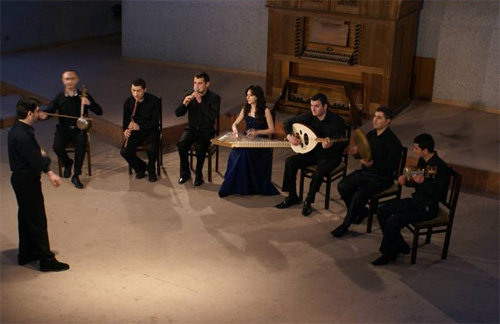

|
Levon Eskenian and the Gurdjieff Folk Instrument Ensemble


|
|
Levon Eskenian and the Gurdjieff Folk Instrument Ensemble What a curious journey the music on Levon Eskenian’s Gurdjieff Folk Instruments Ensemble’s The Music of Georges I. Gurdjieff has taken. It began as the folkloric music Georges Gurdjieff heard in his travels through the near and middle east, was filtered through Gurdjieff’s ear to his collaborator/student Thomas de Hartmann, and finally was re-arranged for traditional Armenian instruments by Levon Eskenian, whose Gurdjieff Folk Instruments Ensemble perform on this ECM release. Gurdjieff, known for his mystical philosophy and syncretic religious views, placed a high value on music and was a talented musician/composer himself. As he travelled through his native Armenia, as well as many other parts of the middle east and central Asia, he collected folk instruments and committed songs and dance tunes to his memory. Between 1917 and 1929, the Russian musician Thomas de Hartmann transcribed and co-arranged many of these pieces for piano. Since the early 20th century, these pieces have enjoyed a robust respect, albeit in a rather small circle (Keith Jarrett recorded an album of them in 1980).
 From the folkloric sources to the Gurdjieff/de Hartmann piano pieces, there was a considerable metamorphosis required of the music, much of it coming from decidedly non-equal 12 systems. The necessity of making artistic choices in bridging the various tuning systems makes one wonder if one is listening to a game of musical telephone in hearing the transcriptions back to traditional instruments. However, no matter how the music has changed through the journey, what is committed to the recording is absolutely worth listening to. These are not, after all, source recordings of folkloric material, but interpretations of the works of a specific composer(s). They just happen to be on instruments that the source music would have been played on. The timbral variety provided by the various string and wind instruments greatly enriches the Gurdjieff/de Hartmann pieces, which, taken in a large dose on the piano, tend towards a monotony of tone. The phrasing demonstrated on The Music of Georges I. Gurdjieff, along with the tempo choices, allows these tunes to breath as they can’t when performed on a piano (the greatest pianist cannot coax a crescendo from an already sounding note). The gentle obbligato strumming of the strings is much more subtle than the same figure could ever be on a piano, and hand drums take on much of the structural rhythmic duties, freeing the melody instruments and allowing the accompanying strings to contribute shimmering textures. The musicianship of this ensemble is outstanding, and the recording quality highlights it admirably. The liner notes, printed in typical ECM black and white, give brief background information about Gurdjieff as well as about the project and the chosen selections. - Erik Keilholtz More about the ensemble: www.gurdjieffensemble.com Photo courtesy of ECM Records, ©2011
|
|
|
|